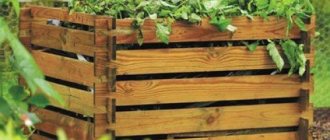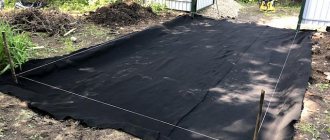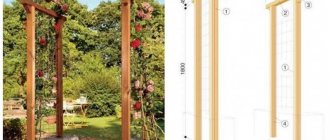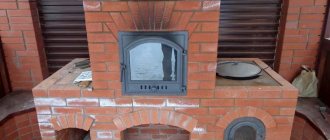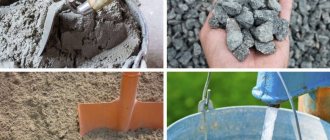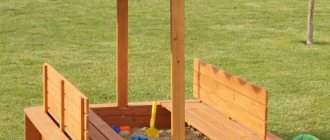A compost bin is an indispensable attribute of every country farm, but often it looks just like a hole or a pile of garbage. This is far from the optimal option: being dumped in a heap, organic waste will not be properly processed in full and will not be able to turn into high-quality fertilizer.
The best choice for a gardener is to make a special compost bin with your own hands or buy a ready-made one that meets the requirements in order to completely process waste into a useful substrate.
Criterias of choice
Main criteria when choosing a box:
- size;
- material;
- design;
- manufacturer.
Most often, gardeners buy or make their own compost bins with a volume of 600 to 1000 liters. They can be made of wood - in particular, pallets (pallets) of plywood, slate, polycarbonate or corrugated sheets, metal mesh. Factory-made copies are often made of polypropylene, metal, plastic, and may have a door at the bottom for easy removal of fertilizer.
The main “participants” in the composting process are insects and microorganisms that are aggressive enough to feed on table and garden waste.
By and large, it doesn’t matter to them what exactly to process - the garbage itself or the material from which the composter is made, therefore, if the box for humus is built from wood (you can use a slab), you should give preference to hardwood and pay attention to the quality of the boards: they must be strong, thick, and must be treated with anti-rotting agents or carefully painted.
To ripen high-quality compost, good aeration, heat and humidity are necessary, so the boards are not laid end-to-end, but so that there are gaps between them to ensure air access.
Some factory composter models are even equipped with drums for easy loosening of the product. This is convenient, but not necessary: if the compost heap is formed correctly, it is possible to mix it without additional devices.
What materials to use
To build a country composter, you can use any available materials. The main load will be borne by the frame, which can be constructed from thick boards, timber, or pipe profiles. The side walls are sutured:
- boards;
- slate;
- sheet metal;
- polycarbonate;
- dense polyethylene;
- plywood or chipboard, etc.
The most popular material for building a compost bin is wood. It can be an unplaned board, slab, thick plywood, etc. Wooden elements are easy to install, they are environmentally friendly and affordable.
For work, you will need a shovel for digging holes for racks, fasteners for assembling walls and, if necessary, fittings for installing boards, doors, and sashes. The material is attached to the frame with screws or nails using a screwdriver or hammer. Elements of the structure are prepared to specific dimensions using a construction tape and sawed off with a hacksaw, grinder or jigsaw.
Important nuances of composting
In order for organic materials to be processed efficiently (in a short time and completely), the following is necessary:
- carbon;
- oxygen;
- nitrogen;
- water.
Before laying, the compost must be crushed as much as possible. It usually matures after two years, but you can use chemicals to speed up the process, in which case one season will be enough. You can also use sectional composters, where some of the fertilizer ripens by the first spring.
The components of humus can be divided into two categories. The first is nitrogenous (green):
- manure and bird droppings;
- mown grass, weeds (without seeds and roots), dense stems of cultivated plants;
- vegetable food waste.
The second group is carbon (brown) materials:
- chopped wood;
- straw and hay;
- dry leaves;
- bark, sawdust, branch cuttings;
- clean (not coated, unprinted) paper and cardboard.
The best composition of compost is a mixture of waste from the green and brown groups, mixed evenly for better contact or laid in thin levels interspersed with layers of manure: this creates the balance of substances released during decay necessary for complete decomposition.
Bookmark
But it’s not enough to just make a composter with your own hands and throw plants into it. In order to obtain ideal high-quality fertilizer at the end, it is necessary to fill it correctly.
- Raw materials are placed only in the first box. Before this, it is crushed into pieces of approximately the same height - this way the decomposition process will occur more evenly. Any plant can be used as plant material – grass, leaves and branches. In this case, it is better to plant weeds without seeds.
- And it’s even better to put future fertilizer in the composter after rain or any precipitation, when it’s already quite warm outside. In this case, all the necessary conditions for normal compost creation will be obtained naturally.
How to build a compost bin
Despite the abundance of composters in garden stores, many dacha owners prefer to build a compost box with their own hands, fortunately it is not difficult, few building materials are required, and the finished box does not require transportation.
Selecting a location
The compost bin should be installed in partial shade so that the substrate does not dry out under the scorching rays; It is important that there is a convenient path or even a paved path for access - the compost will have to be looked after, and then actively used.
It is logical not to place the box in the immediate vicinity of the house: few people will like the smell of decomposition, the close proximity to worms and beetles, and sometimes rats (a similar nuisance is possible if you add large quantities of leftover bread and other waste edible to rodents to the compost).
Slate box
A slate box is more reliable than a wooden one. The slate is wavy - the structure will be ventilated through the cracks created by its shape. It is cut with a grinder or a circular saw; before cutting, you need to draw up a drawing and carry out actions according to the diagram. Manufacturing technology step by step:
- The board frame is fastened with self-tapping screws;
- grooves for slate are dug along the perimeter of the future structure;
- the walls are installed in the grooves;
- The frame is installed inside and fixed with special nails for slate.
Slate is a fragile material and must be handled very carefully.
It is better to make the lid for any composter from wood or other lightweight raw materials. It should be dense, not allow moisture and sunlight to pass through. Many gardeners do not make a bottom, but this risks the compost drying out and rodents entering the mass. It is better to spend time building a ventilated bottom from mesh or boards, or at least ensure good drainage: instead, make a dense, at least 25 cm, flooring of branches.
Review of popular models
Online markets allow you to sort products by popularity and from time to time publish ratings of the most popular products.
Top sellers in Russia:
- plastic KETER Eco Composter from 300 l with lids, ventilation holes, reliable locks;
- Polish composters Prosperplast, also made of plastic and with ventilation, 800 l, with several sections,
- domestic “Master Sad” - they are valued for their lightness of construction, convenience, and affordable cost.
Recommendations
Experienced gardeners say that compost containers will be more effective in producing fertilizer if you keep a few rules in mind.
- Although weeds can also be used for fertilizer, it is best to store them separately. To do this, you can select a separate box in the composter or even make a separate box for them with your own hands.
- The smaller the size of the raw material, the faster the compost obtained from it will be ready for use. Therefore, it is recommended, if possible, to chop plants as finely as possible, especially large grass and branches.
- In addition to garden plants, you can also fill containers with food waste from fruits and vegetables. The increased content of starch and sugars in them will only speed up the process of compost maturation.
- It is necessary to water the compost with warm water. But it is much more effective to use a special herbal infusion. To do this, freshly cut nettles need to be slightly dried in the shade, stuffed into a barrel and filled with water. Leave in the sun for 2 weeks, and then use the resulting liquid for irrigation.
- And one more thing: to protect the contents of the composter from small rodents or earthworms, the inside should be lined with a metal mesh with small cells.
The principle of operation of the country option
The purpose of installing a wooden or other compost box at a summer cottage is to create comfortable conditions for microorganisms that process organic waste into fertilizer through biodegradation.
The box serves to maintain a consistently high temperature in the compost heap, prevents it from dehydrating, and interferes with communication with the external environment (which prevents the appearance of dangerous parasites in the humus, the proliferation of weeds, and contamination of the garden plot with waste).
After laying, the compost begins to rot. During the season, it should be stirred from time to time so that the substances released during degradation are evenly distributed throughout the volume. The output is a homogeneous mass with small inclusions of unprocessed elements (twigs, wood chips).
Types of structures
Tops, foliage, and mown grass are rich in nitrogen and phosphorus. When using ready-made compost from garden waste, you will get an environmentally friendly harvest without the use of ready-made store-bought fertilizers.
Country composters can be classified by the number of compartments.
Singles
You can build a single large box, which you will fill throughout the summer season. It is also possible to build a long box divided into several compartments. Single structures are built in different parts of the garden and collect waste that is located closest to them;
With several departments
In a composting bin with 3-4 compartments, you can organize several bookmarks at once, which can be created according to the type of waste being stored. For example, beet or carrot tops turn into full-fledged top dressing after just 6 months, and it will take at least two years for potato or tomato bushes to rot.
If the area is small, one large box is enough, where you will place all the organic matter that can rot.
Useful! It is easy to assemble a compost bin from pallets. Strong structures are lattice walls that will reliably hold organic matter.
Also, structures for preparing compost may differ in the way the walls are attached. You can remove the boards by unscrewing the screws or remove them from a specially constructed groove. It is also convenient to make one of the walls in the form of vertically opening doors on regular door hinges. The doors themselves are mounted in the middle of the wall on a horizontal crossbar. Fixation is carried out using a latch or latch. If it is necessary to remove compost, open the bottom flap and remove the fertilizer with a pitchfork. The top layers of compost move down and you can start laying again.
Compost container options
The most common options for laying compost in Russia:
- homemade composters from scrap materials and household items (for example, a barrel with holes drilled for ventilation) are widely used, but are not always convenient: they have a too narrow “neck”, are not aerated enough, and do not use space optimally);
- factory boxes are good for their ergonomics, presentable appearance, strength, and the fact that they are often collapsible, but nevertheless they are not cheap;
- capital (immovable) independent buildings from excess building materials, erected in a certain place on the site reserved for compost;
- compost pits.
The last option is the most basic. It’s better than nothing, but it’s only suitable for a demanding gardener for the first time, as it’s significantly inferior to even a primitive box.
The humidity in the pit is difficult to control, it is inconvenient to get compost from its bottom, and it does not provide protection from wild animals (for example, rats). In addition, the pit will have to be covered with something to protect the substrate from rain, snow and direct rays of the sun - a tarpaulin or film can easily be blown away by the wind, and the cover will need to be made separately.
Adviсe
The following tips may be helpful when making your compost bin:
- The easiest way is to make a container from wooden beams and slats; before installation, they should be impregnated with a water-repellent composition; it is cheaper to use used machine oil.
- Since the ripening time of humus when adding accelerators takes 1 year, it is better to apply them in early spring so that the fertilizer is laid out before planting crops.
- During the ripening process, the compost heap must be periodically moistened and mixed; cow manure, chamomile, dandelion, and yarrow infused in water are used as a homemade ripening accelerator.
- The composter must be located in a shaded place at the maximum distance from water intake sources (wells, wells) if they are available on the site, the optimal height of the box is 1 m.
Rice.
10 Types of compost facilities The use of compost technologies in households allows not only to recycle a significant amount of waste, but also to obtain environmentally friendly fertilizer based on it for feeding garden crops. If you have the financial resources, it is not at all necessary to make a composter container yourself from available components - the retail chain sells a number of easy-to-use models made from durable, corrosion-resistant polymers that have an aesthetic appearance and colors suitable for most areas.
Where to start making compost pits
Before you make a box or pit for compost, you need to determine the location of the future “sump”. Ideally, it should be located at a distance of at least 30 m from the walls of a residential building, but not all land owners have such space at their disposal, so you can focus on the figure of 10 m. In addition, the compost heap or pit should be located:
- no less than 5 m from the neighbor’s fence, road, toilet, shower;
- at least 25 m from natural bodies of water;
- at least 50 m from an artificial source of water supply (for example, a pump).
Capital construction options
If you make a compost bin with your own hands, then, most likely, it will be non-dismountable and non-transportable. It is worth taking care of the presence of a mesh bottom and placing the future composter at a short distance from the crops. In addition to plank and slate, the box can be:
- brick or concrete (these are not very popular options, as they are expensive and bulky);
- from metal sheets;
- from plastic panels and other synthetic materials.
The box is sheathed with panels or sheets on the outside, leaving gaps for air to penetrate into the thickness of the substrate. The lid should be hinged or removable so that it is easy to throw new portions of waste into the composter.
Design selection
The main difference between composters of different price categories is the open or closed type of tank. Closed ones are more expensive, but they better protect the product (in particular, they can be left outside in winter, even during snowfalls) and contribute to faster processing of the material into finished compost due to better temperature retention.
Open composters are cheaper. They are best used in large areas, while standard sizes of closed structures range from 200 to 1000 liters.
Creating conditions
In order to obtain fertilizer from plants, it is necessary that they rot well and turn into a crumbly substance rich in vitamins and minerals, which increases the fertility of the soil and the volume of the harvest.
To do this you need:
- Make sure that the temperature inside the composter itself never drops below +16 degrees. Otherwise, the fermentation process will stop, and the plants will simply deteriorate; it will simply be impossible to use them later as fertilizer.
- The humidity level also plays a big role - it should be at least 60%. Otherwise, the compost will rot or dry out. Therefore, depending on the air temperature outside, it is watered with warm water 1-2 times a week.
- And it is also necessary to transfer the compost to the next compartment every year. This is necessary because in a composter the bottom layer of plants is ready for use as fertilizer after a year. But if you constantly replenish the box, do not rearrange or sift the raw materials, then it will simply disappear. Therefore, after a year, the semi-finished compost is transferred to the second compartment of the box, and the first is again filled with new raw materials.
Types of composters
In addition to conventional boxes of various models, modern improved designs are produced - for example, thermocomposters, which allow you to get results in an accelerated mode by constantly maintaining a very high temperature. These are closed barrels or hemispheres, often sealed, quite compact and look good in the landscape (attention is paid to design).
There are vermicomposters where the main “employees” in processing the material are worms, which are placed specifically in the appropriate tank. The composter with worms is practically airtight, it can be installed not only outdoors, but also in a building, which helps to obtain mature compost all year round.
Video description
Watch a video about the construction of a wooden composter:
Mesh composter
A suitable material for making a composter is a durable galvanized steel mesh with cells of any size. In addition to this, you only need wire and air-permeable non-woven material - spunbond or lutrasil.
- A cylinder is rolled out of the mesh, making an overlap of 15-20 cm, and fastened with soft wire.
- The resulting basket without a bottom is placed in place, having first removed the turf from the ground, and tied to a fence, pole, or any other support.
- The inner walls are covered with spunbond.
If appearance is not important, you can do without non-woven material Source myhappyhomestead.com

